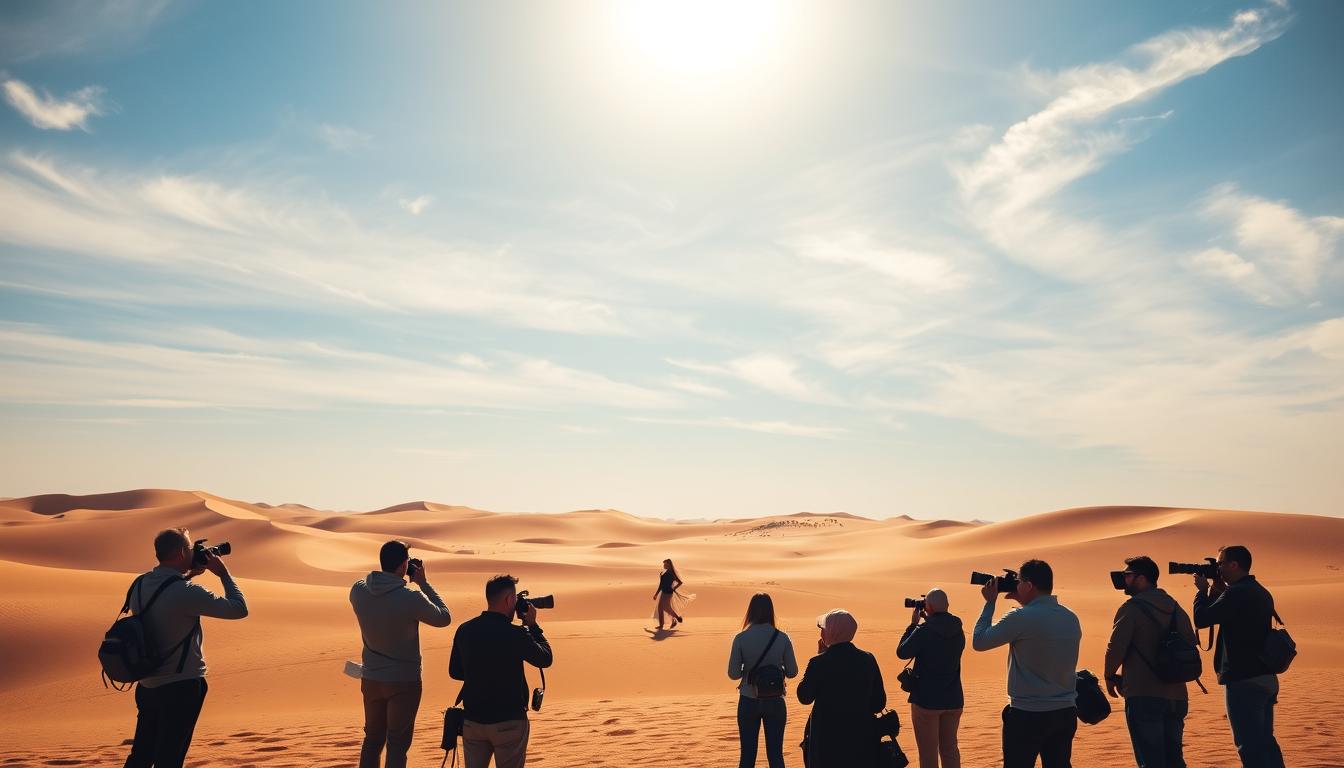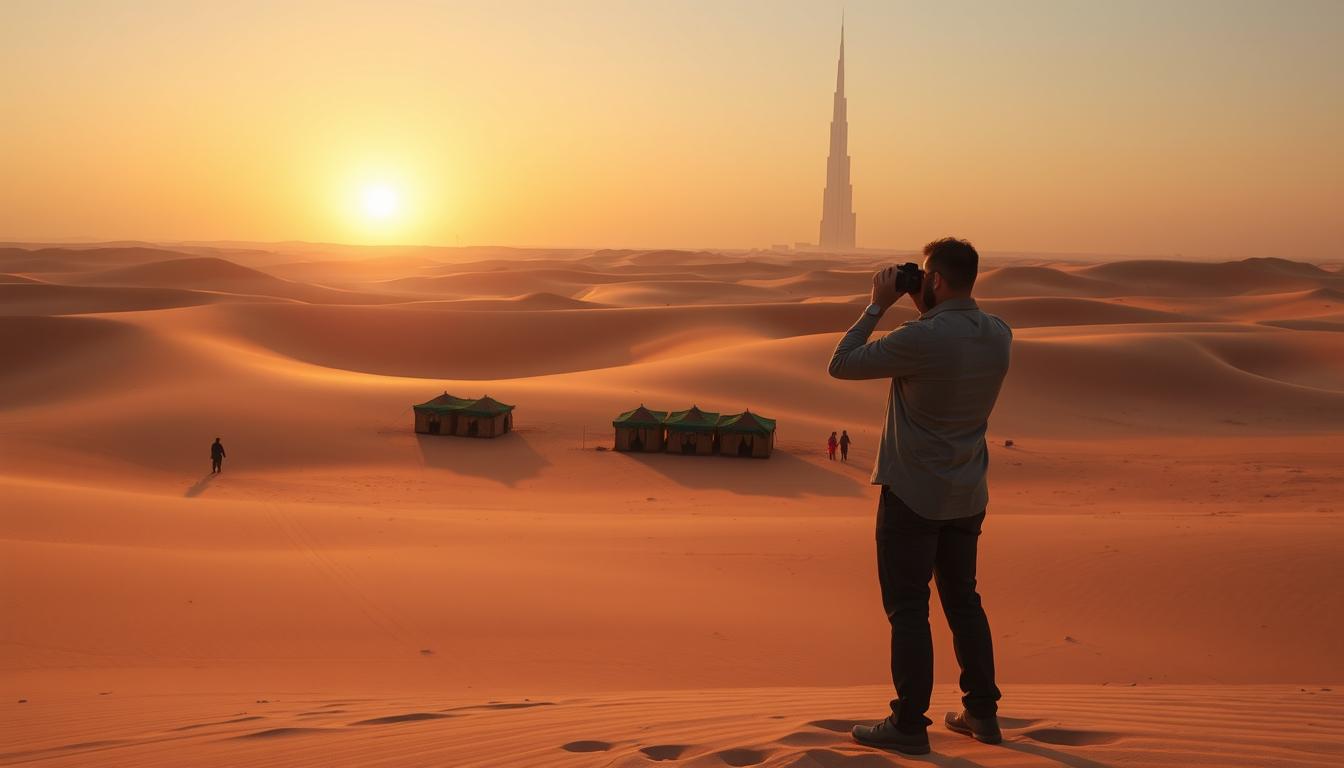Imagine the sun setting over Dubai’s golden dunes. A warm glow surrounds everything. As night approaches, you might wonder, “Will it get cold?” Understanding the Dubai Desert Safari’s temperatures is crucial. It ensures your experience is both fun and comfortable. As day turns to night, temperatures drop, but with the right knowledge, you can enjoy the desert’s beauty without feeling cold.
Key Takeaways
- The Dubai Desert experiences significant temperature drops at night.
- Understanding the Dubai Desert Safari temperature range helps in planning your trip.
- The weather in Dubai Desert Safari varies seasonally, affecting your experience.
- Evenings can be cool, so dress accordingly to enjoy nighttime activities.
- Timing your visit aligns with the best weather conditions for your safari.
- Nighttime safari tours require preparation for cooler temperatures.
Understanding the Dubai Desert Safari Weather
The Dubai Desert Safari weather is key to planning your journey. Knowing the desert climate helps you get ready. This ensures an unforgettable adventure.
General Climate Overview
Dubai’s weather is hot in the day and cooler at night. Summers can see temperatures over 100°F (38°C). Winter is milder, perfect for desert safaris.
Typical Weather Patterns
Rain is rare in Dubai, with about 3 inches a year, mostly in winter. Knowing the weather is crucial, especially for activities like Dune Buggy and Quad Biking Tours.
| Season | Average Day Temperature (°F) | Average Night Temperature (°F) | Rainfall (inches) |
|---|---|---|---|
| Winter (Dec-Feb) | 70-80 | 50-60 | 1.2 |
| Spring (Mar-May) | 80-95 | 60-75 | 0.8 |
| Summer (Jun-Aug) | 95-110 | 75-85 | 0.2 |
| Autumn (Sep-Nov) | 85-100 | 65-75 | 0.4 |
Does it get cold in Dubai Desert Safari?
Yes, nights in the Dubai Desert Safari can turn quite chilly, especially in winter. After the sun goes down, temperatures drop noticeably. This is most apparent from November to March, when it can get as cold as 50°F (10°C) or lower at night.
Nighttime Temperature Drops
The Dubai Desert Safari evenings offer a unique charm. The shift from day warmth to night cool creates a special vibe. Dressing in layers becomes key for these outings. A light jacket or shawl is helpful for staying cozy while having dinner under the stars or watching traditional shows.
Impact of Seasonal Changes
Seasonal shifts play a big role in the Dubai Desert Safari’s winter climate. Even though days are warm, nights can be much cooler by comparison. This cool weather makes the safari more enjoyable, perfect for stargazing and eating outdoors. Remember these changes to pack right for your trip.
Best Time to Go to Dubai Desert Safari
Planning your trip to the Dubai Desert Safari is exciting. Choosing the right season is key for the best experience. Knowing the climate helps you enjoy activities in great weather.
Seasonal Recommendations
October to April is the best period for Dubai Desert Safari. The weather is cooler, perfect for outdoor fun. It attracts many visitors avoiding the summer heat. People love trying quad biking and evening safaris during this time.
Peak Visiting Times and Temperature Ranges
In winter, the temperature stays around 75°F (24°C). But summer temperatures soar above 104°F (40°C). This difference stresses the need for smart planning. For more on the best seasons for adventures, like quad biking, visit ideal seasons for quad biking.
| Month | Average High Temperature (°F) | Recommended Activities |
|---|---|---|
| October | 85°F (29°C) | Quad Biking, Camel Riding |
| November | 79°F (26°C) | Evening Desert Safari, Dune Bashing |
| December | 75°F (24°C) | Camping, Star Gazing |
| January | 70°F (21°C) | Sandboarding, Cultural Shows |
| February | 75°F (24°C) | Safari Tours, Wildlife Watching |
| March | 82°F (28°C) | Photography, Desert Exploration |
| April | 89°F (32°C) | Sunset Dunes, Night Safari |
Conclusion
Daytime in the Dubai Desert Safari can be very hot. But at night, it gets surprisingly cold. This makes the desert under the stars a magical place to see. It’s important to plan and wear the right clothes for hot days and cool nights.
Knowing the weather in the Dubai Desert Safari is key for a great adventure. Pick the best time to go, and you can enjoy camel rides, sandboarding, and stunning views. Going when it’s cooler makes your visit better and lets you fully enjoy the desert.
If you want a special adventure, think about contacting Dune Buggy Rentals Dubai. You can call them at +971 52 440 9525 or email [email protected]. They’re open 24 hours for bookings. This way, you can explore the beautiful desert and make unforgettable memories under the stars.
FAQ
Does it get cold in the Dubai Desert Safari?
Yes, it can get really chilly, especially at night during the Dubai Desert Safari. Nighttime temperatures from November to March can drop to 50°F (10°C) or even lower. This means you should wear several layers.
What is the typical weather in Dubai Desert Safari?
Dubai has a desert climate, so expect it to be very hot in the daytime. Temperatures often go above 100°F (38°C) in summer. But the winter is milder, which is great for spending time in the desert.
When is the best time to visit the Dubai Desert Safari?
The best time to go to a Dubai Desert Safari is between October and April. The weather is cooler then, making activities like dune bashing and nighttime desert trips more enjoyable.
How does the weather impact desert safari activities?
The weather affects everything you can do in a desert safari. Cooler evenings are perfect for traditional shows and looking at stars. Hot daytime weather is ideal for fast-paced activities such as sandboarding.
Are there cold nights during a Dubai Desert Safari?
Yes, nights during the cooler months can get cold in the desert, so bring warm clothes. This is important for evening safaris and camping.
What should I wear for a Dubai Desert Safari in winter?
It’s best to wear layers because of varied temperatures. Choose light clothes for the day and warm clothes like jackets or shawls for cold nights.
Is rain common in the Dubai Desert Safari region?
Rain is rare in Dubai, mostly falling in winter, with around 3 inches per year. But, it’s wise to check the weather forecast before your trip.
What weather conditions can I expect during a night safari?
Expect cooler temperatures during a night safari, often dropping below 60°F (15°C). Bringing extra layers will keep you comfortable while enjoying the sights and sounds.



